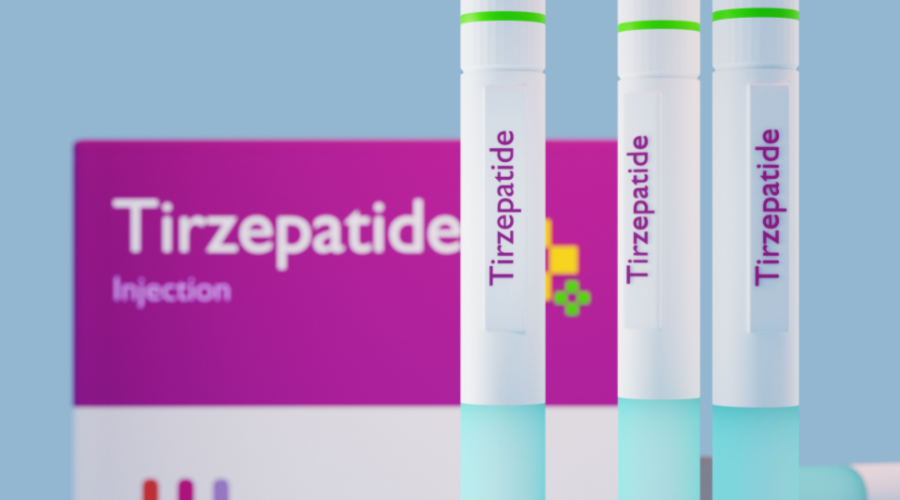A new diabetic medication has entered the scene, and it may be approved for weight loss. If so, this Eli Lilly drug could perhaps become the best-selling drug of all time. But will those who need it be able to afford it?
The drug, tirzepatide (Mounjaro), has experts confident that the Food and Drug Administration will approve it sometime next year. If it does, it’ll join a couple of other popular—and expensive—weight-loss drugs on the market (Saxenda and Wegovy). The difference between the three is that tirzepatide targets more than the GLP-1 receptor. It also mimics glucose-dependent insulinotropic polypeptide (GIP), another hormone involved in insulin secretion.
Tirzepatide causes weight loss in several ways. It signals to the brain that you’re full, so you eat less. It also slows the movement of food through your stomach, so you feel full longer, and it lowers blood sugar.
These newer treatments have made it possible to safely decrease body weight by more than 10 percent through pharmaceutical methods. These newer treatments also improve cardiovascular health.
All three drugs are given as injections, and clinical trials have shown that they’re highly effective for weight loss. What’s more, the three of them work in a similar way. They’re a class of drugs called GLP-1 agonists. These mimic hormones known as incretins, which lower blood sugar and curb appetite.
At lower doses, these drugs have already been approved to treat diabetes.
- Tirzepatide is sold under the name Mounjaro for diabetes. It led to a 21 percent drop in body weight, on average, at the highest dose (compared with 3 percent for the placebo).
- A higher dose of the drug liraglutide is sold for weight loss under the name Saxenda; but at a lower dose, it’s sold for diabetes as Victoza.
- When marketed for weight loss, semaglutide is sold at a higher dose and is known as Wegovy. At a lower dose, it’s marketed for diabetes and is sold as Ozempic.
The cost for tirzepatide is unknown right now; however, outside experts estimate it could be priced similarly to a month’s supply of Wegovy (around $1,500), or Saxenda (around $1,350). Researchers estimate the cost for tirzepatide could be about $13,000 annually, or about $1,100 per month.
One thing that tirzepatide does that the others don’t is mimic another hormone involved in insulin secretion (glucose-dependent insulinotropic polypeptide (GIP)), in addition to targeting the GLP-1 receptor. While reasons for this are still unknown, the levels of weight loss following tirzepatide treatment near those that are typically only achievable through bariatric surgery. After six months, body weight reduces by 30 percent and the weight loss continues up to two years.
These drugs, with the exception of Mounjaro and its recent approval, are covered by most insurance. However, this isn’t always the case. Obesity drugs aren’t always covered by insurance because they carry a unique stigma. Most physicians view obesity as a behavioral problem, not a medical one. In fact, insurance companies often need more proof of the benefits of anti-obesity drugs than they do for other medications. And while some insurers may offer coverage for one of the weight-loss drugs, they often restrict access only to patients who meet a certain threshold, such as a BMI greater than 30. But what if the covered drug doesn’t work for them? Everyone responds differently to any given weight-loss drug. So, if the drug their insurance covered doesn’t work for them, they’re typically out of luck. There are usually no other options left.
The same goes for private insurance, where coverage for anti-obesity medications is sporadic. Treatments are often confined to the most expensive plans. Medicare will not cover them because anti-obesity drugs aren’t mandatory. However, some states have opted to include them.
“These new medications with an indication for weight loss can be effective especially for patients who can’t necessarily exercise and diet,” said Nick Smock, President and CEO of PBA Health, PharmD, MBA, President of FPN, Vice President of APHA, and member of various state pharmacy and national associations. “This can enhance our profession and practices, not only dispensing the medication, but this is a huge opportunity for pharmacists to implement weight-loss and healthy-living programs into their clinical or consulting practices. We as pharmacists have been trained in pharmacy school to deal with most disease states, such as asthma, COPD, CAD, smoking, diabetes, blood pressure, lipidemia, and so on. Adding a weight-loss program to your offering would benefit numerous patients of the independent pharmacy.
Whatever the upfront costs may be, scientists stress the importance of addressing obesity. By doing so, it could allow healthcare systems to save immense amounts of money by reducing numerous conditions that are linked to the disease.
No matter what, healthy eating and exercise will always be a part of treatment. These drugs are a promising addition to the mix. They act through biological mechanisms, which gives some researchers hope that this will help people understand that a person’s body weight is often beyond their control through lifestyle changes alone.
From the Magazine
This article was published in our quarterly print magazine, which covers relevant topics in greater depth featuring leading experts in the industry. Subscribe to receive the quarterly print issue in your mailbox. All registered independent pharmacies in the U.S. are eligible to receive a free subscription.
More articles from the March 2023 issue:
- The Best Software Systems
- New Obesity Drug
- Unexpected Partnerships
- Adding a Private Label
- Get Ready for the DSCSA
- Allergy OTC Season
- Business Loans for Your Pharmacy
- Pharmacy Shortages
A Member-Owned Company Serving Independent Pharmacies
PBA Health is dedicated to helping independent pharmacies reach their full potential on the buy-side of their business. Founded and run by pharmacists, PBA Health serves independent pharmacies with group purchasing services, wholesaler contract negotiations, proprietary purchasing tools, and more.
An HDA member, PBA Health operates its own NABP-accredited warehouse with more than 6,000 SKUs, including brands, generics, narcotics CII-CV, cold-storage products, and over-the-counter (OTC) products — offering the lowest prices in the secondary market.












